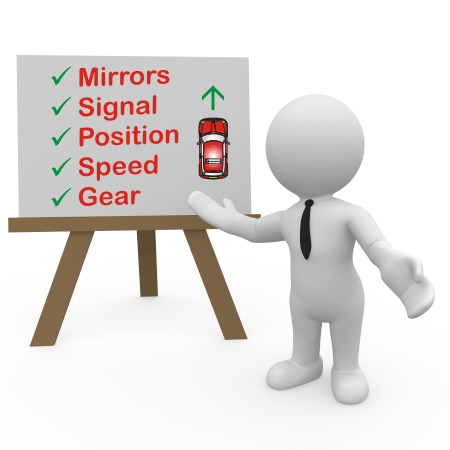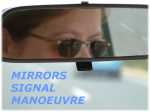Welcome to Section Four
 You know what you mean. But do others understand what you are trying to tell them? The ability to communicate effectively with other road users is essential for safe driving.
You know what you mean. But do others understand what you are trying to tell them? The ability to communicate effectively with other road users is essential for safe driving.
The ability to communicate with yourself is perhaps even more important.
By honing your Mirrors Signal Manoeuvre routine (MSM) you will always know where you are and what you are doing... And so will everybody else!
'Advanced' hazard routines start with the basics of: 'Mirrors, Signal Manoeuvre'
As with some other aspects of this course the concept of learning about MSM may seem to be very basic.
However, many experienced drivers (and some instructors!) sacrifice safety and increase their risk of accidents because they do not habitually drive in a routine fashion.
With this section you will start to perfect your driving ability to drive using a routine approach and gain one of the most important parts of your development as an advanced driver and driving instructor.
In addition to developing a routine approach, practising the MSM routine will also develop the high concentration level essential for a Part-Two and/or Cardington pass and for the hours that you will be earning your living in the tuition seat.
Because the ideas discussed above are critical for Part-Two and Part-Three success, you should devote as much time as you can possibly spare to this 'simple' aspect of your driving.
Driving to a system
 A full understanding of the need to apply a systematic approach to driving will do much to enhance your driving - if you are a student instructor it will increase your potential to teach driving successfully.
A full understanding of the need to apply a systematic approach to driving will do much to enhance your driving - if you are a student instructor it will increase your potential to teach driving successfully.
You can only gain the necessary depth of understanding through effective, methodical practise.
When completing the practise sessions for this section, remember (once again) to think about the 'What?', 'When?', 'Where?', 'How?' and 'Why?' of all your actions.
By doing this you will go a long way towards gaining the confidence needed to effectively assess your own driving during Part-Two and to deal with 'awkward' examiners during Part-Three.
'What? and Why?' example
"It is important to check your mirror before starting to slow down and/or stop at a red traffic light."
The above statement is correct, it's what you have to do, but why is it correct?
Could you convince a friend about the importance of mirror use if he/she thinks that it is unnecessary to make a mirror check?
(For example: "If the lights are red I have to stop anyway no matter what's happening behind".)
Arm signals are not used as much as they used to be. This is because all cars are now fitted with clearly visible indicators. However, arm signals can sometimes be more useful than indicator signals and are often valuable as a reinforcement of indicator signals. The arm signal project will acquaint (or reacquaint) you with the fine art of giving arm signals.
In addition to methodical driving, this week will further develop your commentary driving skills and , of course, complete your weekly car checks.
Arm signal project This project will reinforce your understanding of arm signal use and help ensure your proficiency when using arm signals.
Hills: This section also contains information about dealing with hills.
Car care and Commentary: The car care project will have you crawling around your vehicle to find more bits... And the commentary project will start to develop your talking skills to build the driving picture more fully.
Mental rehearsal
Mental rehearsal is a powerful way to prepare yourself for any performance, an interview, an exam, a driving test, asking someone out for a date... Or whatever. In this section we provide a step-by-step guide to using this technique.